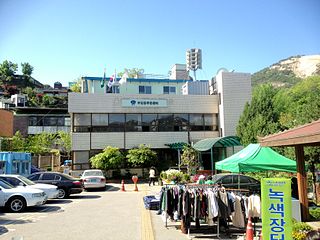
Glutinous rice is a type of rice grown mainly in Southeast East Asia, the northeastern regions of India and Bhutan which has opaque grains, very low amylose content, and is especially sticky when cooked. It is widely consumed across Asia.

Meghalaya is a state in northeast India. Meghalaya was formed on 21 January 1972 by carving out two districts from the state of Assam: (a) the United Khasi Hills and Jaintia Hills and (b) the Garo Hills. The estimated population of Meghalaya in 2014 was 3,211,474. Meghalaya covers an area of approximately 22,429 square kilometres, with a length-to-breadth ratio of about 3:1.

Camellia sinensis is a species of evergreen shrub or small tree in the flowering plant family Theaceae. Its leaves, leaf buds, and stems can be used to produce tea. Common names include tea plant, tea shrub, and tea tree.

Majuli (Mazuli) is a large river island located in Assam,(a north eastern state) India. It is formed by the Brahmaputra River to the south and east, the Subansiri River to the west, and an anabranch of the Brahmaputra River.

Assamese cuisine is the cuisine of the Indian state of Assam. It is a style of cooking that is a confluence of cooking habits of the hills that favour fermentation and drying as forms of preservation and those from the plains that provide extremely wide variety of fresh vegetables and greens, and an abundance of fish and meat. Both are centred on the main ingredient — rice. It is a mixture of different indigenous styles with considerable regional variations and some external influences. The traditional way of cooking and the cuisine of Assam is very similar to South-East Asian countries such as Thailand, Burma (Myanmar) and others. The cuisine is characterized by very little use of spices, little cooking over fire, and strong flavours due mainly to the use of endemic exotic fruits and vegetables that are either fresh, dried or fermented. Fish is widely used, and birds like duck, pigeon, squab, etc. are very popular, which are often paired with a main vegetable or ingredient; beef used to be eaten before British colonialism, and some continue to do so. Preparations are rarely elaborate. The practice of bhuna, the gentle frying of spices before the addition of the main ingredients so common in Indian cooking, is absent in the cuisine of Assam. The preferred oil for cooking is the pungent mustard oil.

Parkia speciosa, the bitter bean, twisted cluster bean, sator bean, stink bean, or petai is a plant of the genus Parkia in the family Fabaceae. It bears long, flat edible beans with bright green seeds the size and shape of plump almonds which have a rather peculiar smell, similar to, but stronger than that of the shiitake mushroom, due to sulfur-containing compounds also found in shiitake, truffles and cabbage.

Lemang is a Minangkabau traditional food made from glutinous rice, coconut milk, and salt, cooked in a hollowed bamboo tube coated with banana leaves in order to prevent the rice from sticking to the bamboo. Originating in Indonesia, it is also found in Singapore, Malaysia, and Brunei, as similar dishes made from sticky rice in bamboo are common throughout Mainland Southeast Asia.

Pithas are a variety of food similar to pancakes, dumplings or fritters, originating from India and Bangladesh. Pitha can be sweet or savoury, and usually made from a dough or batter, which is then steamed, fried or griddled. Very few varieties are oven-baked or boiled, and most are unleavened and cooked on a stovetop. Some versions may have a filling, garnish, or sauce. Few may be set or shaped after cooking. They are typically eaten as a snack with chai, or as treats during special occasions.

Saffron rice is a dish made from saffron, white rice and also usually vegetable bouillon. Saffron rice is found in the cuisines of many countries. The recipe is similar to plain cooked rice with addition of ingredients.

The Economy of Assam is largely agriculture based with 69% of the population engaged in it.
Bora saul is a variety of glutinous rice found in Assam, India. It has an important role in festivals of Assam. During traditional occasions like Bihu, this variety of rice is eaten with served with doi (curd), gur (jaggery) and cream.
Jolpan, or snacks, are often served at breakfast in the cuisine of Assam, although they may also be served at Bihu festivals or weddings. The word jolpan includes all the preparations namely jolpan, pitha, laru and tea. Other common items served for breakfast may include roti, luchi, ghugni and sometimes paratha etc. Jolpan are also found in Bengal. The word literally derives from "water and betel leaf" but can mean any snack.

Buam-dong is a dong (neighborhood) of Jongno District, Seoul, South Korea.

Rice production in India is an important part of the national economy.

Deepwater rice are varieties of rice grown in flooded conditions with water more than 50 cm (20 in) deep for at least a month. More than 100 million people in Southeast Asia including Northeastern India rely on deepwater rice for their sustenance. Two adaptations permit the rice to thrive in deeper water, floating rice and traditional talls. Traditional talls are varieties that are grown at water depths between 50 and 100 cm and have developed to be taller and have longer leaves than standard rice. Floating rice grows in water deeper than 100 cm through advanced elongation ability. This means when a field where rice is growing floods, accelerated growth in the internodal of the stem allows the plant to keep some of its foliage on top of the water. The O. s. indica cultivar is the main type of deepwater rice, although varieties of O. s. japonica have been found in Burma and Assam Plains.

Farming systems in India are strategically utilized, according to the locations where they are most suitable. The farming systems that significantly contribute to the agriculture of India are subsistence farming, organic farming, industrial farming. Regions throughout India differ in types of farming they use; some are based on horticulture, ley farming, agroforestry, and many more. Due to India's geographical location, certain parts experience different climates, thus affecting each region's agricultural productivity differently. India is very dependent on its monsoon cycle for large crop yields. India's agriculture has an extensive background which goes back to at least 9 thousand years. In India, in the alluvial plains of the Indus River in Pakistan, the old cities of Mohenjo-Daro and Harappa experienced an apparent establishment of an organized farming urban culture. That society, known as the Harappan or Indus civilization, flourished until shortly after 4000 BP; it was much more comprehensive than those of Egypt or Babylonia and appeared earlier than analogous societies in northern China. Currently, the country holds the second position in agricultural production in the world. In 2007, agriculture and other industries made up more than 16% of India's GDP. Despite the steady decline in agriculture's contribution to the country's GDP, agriculture is the biggest industry in the country and plays a key role in the socio-economic growth of the country. India is the second-largest producer of wheat, rice, cotton, sugarcane, silk, groundnuts, and dozens more. It is also the second biggest harvester of vegetables and fruit, representing 8.6% and 10.9% of overall production, respectively. The major fruits produced by India are mangoes, papayas, sapota, and bananas. India also has the biggest number of livestock in the world, holding 281 million. In 2008, the country housed the second largest number of cattle in the world with 175 million.

Apo, apong, or poka is an alcohol drink commonly found among the Tani tribes in the Northeast India states of Arunachal Pradesh and Assam. It is prepared by fermentation of rice. It is known by various names across different tribes in Arunachal Pradesh and Assam.

Majuli district is situated on Majuli, the largest river island in the world, in the Brahmaputra River in Northeastern Assam. It is also the first island district of the country.
Boka Chaul is a variety of short-grained rice mainly grown in the Indian state of Assam. It is a common and widely cultivated crop in the Lower Brahmaputra Valley Zone of Assam, encompassing the districts of Dhubri, Kokrajhar, Chirang, Bongaigaon, Goalpara, Barpeta, Nalbari, Baksa, Kamrup Rural, Kamrup Metropolitan, Darrang, and Udalguri falling in Lower Assam division. Boka Chaul is a brand or group name associated with a specific type of parboiled rice. This rice is produced by parboiling whole grains of a unique winter rice variety called Boka dhan. Soaking the kernels in cold water is sufficient to prepare Boka chaul for consumption.

















